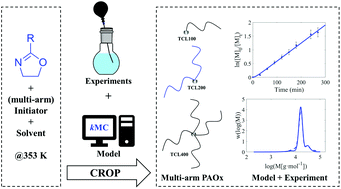Differences and similarities between mono-, bi- or tetrafunctional initiated cationic ring-opening polymerization of 2-oxazolines†
Abstract
Cationic ring-opening polymerization (CROP) is an interesting synthesis technique to obtain well-defined polymers with narrow molar mass distribution (MMD). Upon using a multifunctional initiator, well-defined multi-arm or star polymers can be obtained, provided that the chain initiation is controlled and star coupling is minimized or even avoided. In the present work, experimental data recording and kinetic Monte Carlo modeling are combined to identify differences and similarities upon increasing the functionality degree of tosylate- and nosylate-based initiators for the CROP of several 2-oxazoline monomers (2-ethyl-2-oxazoline (EtOx), 2-n-propyl-2-oxazoline (nPropOx), and 2-isopropyl-2-oxazoline (iPropOx)), while allowing for a variation of the solvent: acetonitrile and chlorobenzene. The synergistic approach taken between experiments and modeling offers a more detailed understanding of the relationship between reaction conditions and molecular properties of poly(2-oxazoline)s (PAOx). This enables the optimization of the reaction conditions and control strategies for the synthesis of well-defined PAOx building blocks. It is further showcased that the simulated log-MMD contains dedicated information on the type of macrospecies present, specifically those related to coupling reactions. The validated model can for instance highlight if linear species have coupled once or more and allows the differentiation between SEC shoulders/peaks that originate from star coupling or just star-to-star compositional deviations.

- This article is part of the themed collections: Polymer Chemistry Lectureship Winners and Synthetic Methodologies for Complex Macromolecular Structures


 Please wait while we load your content...
Please wait while we load your content...